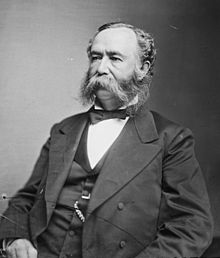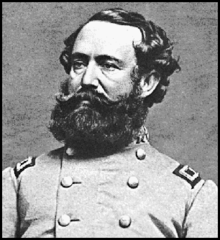Wade Hampton III.
Wade Hampton III. (Born March 28, 1818 in Charleston , South Carolina ; † April 11, 1902 in Columbia , South Carolina) was a general in the Confederate Army in the American Civil War . He was also both US Senator for South Carolina and Governor of that state .
Early years
Hampton was born the eldest son of Wade Hampton II , a wealthy and well-known planter . His ancestors, including Wade Hampton I , were heroes of the War of Independence and the War of 1812 and belonged to the rich aristocratic class of the old south. He learned to ride and hunt in his early childhood at the Millwood manor . After graduating from South Carolina College in 1836, he devoted himself to law, but after graduating, decided to manage the family's cotton plantations in his home state and in Mississippi . From 1852 to 1861 Hampton was a member of the South Carolina House of Representatives on several occasions . From 1858 to 1861 he sat in the Senate of this state .
Civil war activities
Due to his experience as a slave-holding planter, he doubted the economic advantages of this institution , and he initially spoke out against secession . After the outbreak of war, he resigned his senatorial office to serve as a common soldier in the state's militia. However, the governor of South Carolina appointed him regimental commander. Despite a complete lack of military education, the newly minted officer organized the Hampton's Legion . The formation of this association, consisting of six companies of infantry , four companies of cavalry and a battery of artillery , was largely financed by Hampton from his own fortune (he had artillery and coveted Enfield rifles imported from England for his men ). In the first battle at Bull Run , the Hamptons Legion played a pivotal role in the defense of Henry Hill , with Hampton being wounded. He recovered in time to, promoted to Brigadier General on May 23, 1862, to take command of an infantry brigade during the peninsula campaign in spring 1862. At Seven Pines , Hampton was wounded again, but returned to active service at the end of July and took over a cavalry brigade under JEB Stuart , but on the condition that he returned to the infantry as soon as possible. When in December 1862 he was offered the command of an infantry brigade, which had become vacant, Hampton turned it down. He led his troops at Antietam , the Chambersburg Raid and Gettysburg , where he suffered several wounds both on the second day and in a cavalry battle on the third day of the battle. On September 3, 1863 - with effect from August 3 - he was promoted to major general, but due to the severity of his wounds, he was only able to take command of his cavalry division on November 5, 1863 .
In the battle of Trevilian Station (June 11 to 12, 1864), exercising supreme command by virtue of his seniority , he defeated the numerically superior and better armed cavalry corps of the Potomac Army under Major General Sheridan . After the death of JEB Stuart, Hampton officially took over the leadership of the Cavalry Corps of the Northern Virginia Army on August 11, 1864 . On September 16, 1864, Hampton started what became known as the Beefsteak Raid : in the process, he captured over 2,400 cattle and took 304 prisoners, with losses of only ten men. During the siege of Petersburg he found himself forced into a defensive position due to a profound shortage of usable horses and forage to supply them, with his primary responsibility being to protect the communications lines of Richmond , Virginia. In January 1865, Hampton accompanied part of his command to the Carolina States in search of fresh horses. There he was ordered to cover Joseph E. Johnston's retreat through the Carolinas and did not return to Virginia . On February 15, 1865, Hampton was promoted to lieutenant general; He was thus next to Forrest the only cavalry commander of the Confederation who achieved this rank. After the surrender of the Northern Virginia Army under Lee , the war impoverished Hampton reluctantly decided to lay down his arms as well.
Governor of south carolina
After the war, he returned to his family's devastated possessions and tried with moderate success to regain his lost fortune. In 1867 he became politically active again and spoke out against the reconstruction policy of the radical republicans . He gave political and propaganda support to the illegal actions of the Ku Klux Klan , which did not shy away from acts of violence against former slaves and republicans. After Hampton had run for governor in vain in 1865, he was put up by the Democratic Party as the top candidate for the gubernatorial election in 1876 . His rival candidate was incumbent Daniel Henry Chamberlain . The election result was one of the most controversial in the history of the state of South Carolina. At first everything looked like Chamberlain would win the election. However, two counties were controversial because their voices showed irregularities. According to the last, but still controversial, count, Hampton won the election with 50.3% of the vote against Chamberlain's 49.7%. Because of the controversial outcome, both candidates considered themselves victorious and rightful governor. The dispute escalated until April 1877, when the new US President Rutherford B. Hayes signaled that he supported Hampton. At the same time, he withdrew the US army from South Carolina, which had occupied the country since the end of the Civil War. With the withdrawal of the troops, Chamberlain lost his support. He gave up and left South Carolina. Wade Hampton was now the lawful governor of South Carolina. The new governor worked on reducing the national debt and advocated a rapid overcoming of the reconstruction. Public executions were abolished in South Carolina during his tenure . On November 5, 1878, Hampton was re-elected governor without opposition. But he has already appeared in the February 1879 resigned from his post to serve as US Senator in the Congress to change.
Another résumé
From 1879 to 1891 he represented South Carolina in the US Senate in Washington, DC was He then 1893-1897 Railway Commissioner of the Federal Government ( US Railroad Commissioner ). After a hunting accident in 1878, his right leg had to be amputated below the knee. Wade Hampton III died on April 11, 1902 and was buried in Trinity Cathedral Churchyard in Columbia.
literature
- Robert K. Ackerman: Wade Hampton III. University of South Carolina Press, Columbia 2007, ISBN 1-57003-667-5 .
- Rod Andrew, Jr .: Wade Hampton. Confederate Warrior to Southern Redeemer . University of North Carolina Press, Chapel Hill 2008, ISBN 0-8078-3193-X .
- Walter B. Cisco: Wade Hampton. Confederate Warrior, Conservative Statesman. Brassey's, Washington, DC 2005, ISBN 1-57488-626-6 .
- Edward G. Longacre: Gentleman and Soldier. A Biography of Wade Hampton III. Rutledge Hill Press, Nashville, TN 2003, ISBN 1-55853-964-6 .
- Manly Wade Wellman : Giant in Gray. A Biography of Wade Hampton of South Carolina. Reprint, Morningside Bookshop, Dayton, OH 1996 (1949), ISBN 0-89029-054-7 .
Web links
- Wade Hampton III. in the Biographical Directory of the United States Congress (English)
- Wade Hampton III in the National Governor Association (English)
- South Carolina Information Highway (English)
- Wade Hampton III. in the database from Find a Grave (English)
Remarks
- ↑ legions were operations associated forces capable regiments composed of infantry - artillery - and cavalry units existed. As the war went on, they lost this ability.
| personal data | |
|---|---|
| SURNAME | Hampton, Wade III. |
| ALTERNATIVE NAMES | Hampton, Wade |
| BRIEF DESCRIPTION | Confederate general in the American Civil War and politician |
| DATE OF BIRTH | March 28, 1818 |
| PLACE OF BIRTH | Charleston , South Carolina |
| DATE OF DEATH | April 11, 1902 |
| Place of death | Columbia , South Carolina |




